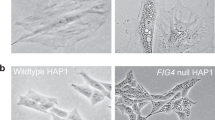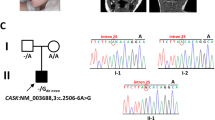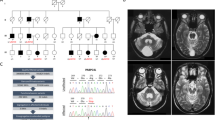Abstract
The peroxisome biogenesis disorders (PBDs) are a group of genetically heterogeneous diseases lethal in early infancy1. Although the clinical features of PBD patients may vary, cells from all PBD patients exhibit a defect in the import of one or more classes of peroxisomal matrix proteins. This cellular phenotype is shared by yeast pex mutants, and human orthologues of yeast PEX genes have been shown to be defective in some groups of PBD patients2,3. We identified a putative human orthologue of ScPEX12 by screening the database of expressed sequence tags for cDNAs capable of encoding a protein similar to yeast Pex12p4. Although its sequence similarity to yeast Pex 12 proteins was limited, PEX12 shared the same subcellular distribution as yeast Pex12p and localized to the peroxisome membrane. PEX12 expression restored peroxisomal protein import in fibroblasts from PBD patients of complement group 3 (CG3) and frameshift mutations in PEX12 were detected in two unrelated CG3 patients. These data demonstrate that mutations in PEX12 are responsible for CG3 of the PBD and that PEX12 plays an essential role in peroxisomal matrix protein import.
This is a preview of subscription content, access via your institution
Access options
Subscribe to this journal
Receive 12 print issues and online access
$209.00 per year
only $17.42 per issue
Buy this article
- Purchase on Springer Link
- Instant access to full article PDF
Prices may be subject to local taxes which are calculated during checkout
Similar content being viewed by others
References
Lazarow, P.B. & Moser, H.W. Disorders of peroxisome biogenesis, in The Metabolic and Molecular Bases of Inherited Disease (eds Scriver, C, Beaudet, A., Sly, W. & Valle, D.) 2287–2324 (McGraw-Hill, New York, 1995).
Dodt, G. et al. Mutations in the PTS1 receptor gene, PXR1, define complementation group 2 of the peroxisome biogenesis disorders. Nature Genet. 9, 115–124 (1995).
Yahraus, T. et al.The peroxisome biogenesis disorder group 4 gene, PXAAA1, encodes a cytoplasmic ATPase required for stability of the PTS1 receptor. EMBO J. 15, 2914–2923 (1996).
Kalish, J.E. et al. Characterization of a novel component of the peroxisomal protein import apparatus using fluorescent peroxisomal proteins. EMBO J. 15, 3275–3285 (1996).
Borden, K.L.B. et al. The solution structure of the RING finger domain from the acute promyelocytic leukaemia proto-oncoprotein PML. EMBO J. 14, 1532–1541 (1995).
Evan, G.E., Lewis, G.K., Ramsay, G. & Bishop, J.M. Isolation of monoclonal antibodies specific for human c-myc proto-oncogene product. Mol. Cell. Biol. 5, 3610–3616 (1985).
Kamijo, K., Taketani, S., Yokata, S., Osumi, T. & Hashimoto, T. The 70 kDa peroxisomal membrane protein is a member of the Mdr (P-glycoprotein)-related ATP-binding protein superfamily. J Biol. Chem. 265, 4534–4540 (1990).
Slawecki, M. et al. Identification of three distinct peroxisomal protein import defects in patients with peroxisomal biogenesis disorders. Cell Sci. 108, 1817–1829 (1995).
Swinkels, B.W., Gould, S.J., Bodnar, A.G., Rachubinski, R.A. & Subramani, S. A novel, cleavable peroxisomal targeting signal at the amino-terminus of the rat 3-ketoacyl-CoAthiolase. EMBO J. 10, 3255–3262 (1991).
Motley, A., Hettema, E., Distel, B. & Tabak, H. Differential protein import deficiencies in human peroxisome assembly disorders. J Cell Biol. 125, 755–767 (1994).
Braverman, N. et al. Human PEX7 encodes the peroxisomal PTS2 receptor and is reponsible for rhizomelic chondrodysplasia punctata. Nature Genet. 15, 369–376 (1997).
Dodt, G. & Gould, S.J. Multiple PEX genes are required for proper subcellular distribution and stability of Pex5p, the PTS1 receptor: Evidence that PTS1 protein import is mediated by a cycling receptor. J Cell Biol. 135, 1763–1774 (1996).
Marzioch, M., Erdmann, R., Veenhuis, M. & Kunau, W.-H. PAS7 encodes a novel yeast member of the WD-40 protein family essential for import of 3-oxoacyl-CoA thiolase, a PTS2-containing protein, into peroxisomes. EMBO J. 13, 4908–4918 (1994).
Winston, R., Dollard, C. & Ricupero-Hovasse, S.L. Construction of a set of convenient Saccharomyces cerevisiae strains that are isogenic to S288C. yeast 11, 53–55 (1995).
Lorenz, M.C. et al. Gene disruption with polymerase chain reaction in Saccharomyces cerevisiae. Gene 158, 113–117 (1995).
Grant, S.G., Jessee, J., Bloom, F.R. & Hanahan, D. Differential plasmid rescue from transgenic mouse DNAs into Escherichia coli methylation-restriction mutants. Proc. Natl. Acad. Sci. USA 87, 4645–4649 (1990).
Altschul, S.F., Gish, W., Miller, W., Myers, E.W. & Lipman, D.J. Basic local alignment search tool. J Mol. Biol. 215, 403–410 (1990).
Gould, S.J., Krisans, S., Keller, G.A. & Subramani, S. Antibodies directed against the peroxisomal targeting signal of firefly luciferase recognize multiple mammalian peroxisomal proteins. J. Cell Biol.. 110, 27–34 (1990).
Michaud, J. et al. Strand-separating conformational polymorphism (SSCP) analysis: Efficacy of detection of point mutations in the human ornithine-d-aminotransferase gene. Genomics 13, 389–394 (1992).
Author information
Authors and Affiliations
Rights and permissions
About this article
Cite this article
Chang, CC., Lee, WH., Moser, H. et al. Isolation of the human PEX12 gene, mutated in group 3 of the peroxisome biogenesis disorders. Nat Genet 15, 385–388 (1997). https://doi.org/10.1038/ng0497-385
Issue Date:
DOI: https://doi.org/10.1038/ng0497-385
This article is cited by
-
A founder mutation in PEX12 among Egyptian patients in peroxisomal biogenesis disorder
Neurological Sciences (2021)
-
A novel mutation in the PEX12 gene causing a peroxisomal biogenesis disorder
Molecular Biology Reports (2015)
-
Whole-exome sequencing in patients with inherited neuropathies: outcome and challenges
Journal of Neurology (2014)
-
Novel mutations in the PEX12 gene of patients with a peroxisome biogenesis disorder
European Journal of Human Genetics (2004)



